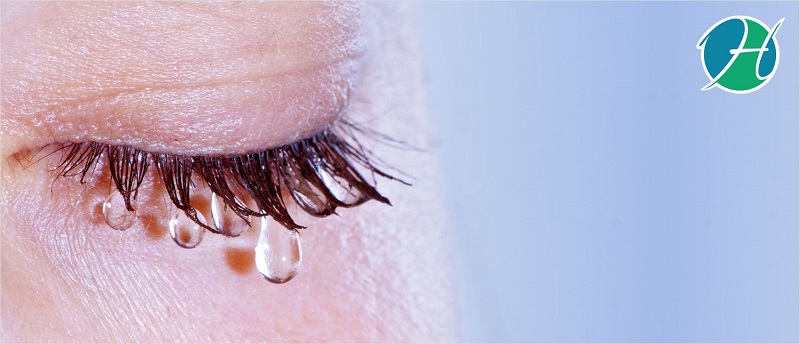Watery eyes: overview, symptoms, causes, diagnosis and management

Watering of eyes is a condition in which there is an overflow of tears from one or both eyes. Rather than a disease itself, it can be a symptom of one of the many underlying abnormality. Production of tears from the lacrimal gland is a normal function. It helps to keep the surface of the eyeball healthy. Tears are drained through the nasolacrimal duct system into nose. They keep running down over the face when the duct system is not able to drain it. Medical term for watery eyes is epiphora.
It can develop at any age but more common in those who are under 12 months of age or above 60 years.
Signs and symptoms
Watering of eyes may not be the only symptom in the patient. There can be other associated signs and symptoms depending upon the underlying cause as
- Reddened eyes
- Eye pain
- Itching
- Allergic reaction causing runny nose or sneezing
- Swelling around eye ball
- Interference with the normal vision
- Sensitivity to light
- Eyelids abnormalities

Causes
Crying or entry of any foreign body is the common cause of watery eyes in people which are otherwise normal. The overflow of the draining duct system causes tears to run down over the face. It can happen either due to overproduction of tears or abnormal duct system
There can be several reasons of improper drainage of tears which includes
- Underdeveloped duct system: newborns often have watery eyes until their duct system develop fully but still in some people it remains blocked
- If the tear ducts are too narrow the tears will not drain properly and get accumulated in the tear sac giving rise to further complications. These ducts can get blocked from infection or inflammation. Disease such as sarcoidosis, lymphoma or trauma may also cause blockage.
- In older people, the eyelids began to sag down. Tears start collecting in the space between the eyeball and the eye lid which eventually flow down over the face.
The conjunctiva is the inner part of the eyelids that covers some part of the eyeball too. The bulging transparent part of the eyeball is called as cornea. Irritation of these structures lead to overproduction of tears which can be caused by
- chemical irritants present in fumes, smoky atmosphere and even onions
- allergic reaction of conjunctiva
- infections affecting eyeball or eyelids
- any injury or trauma to the eye or related structures
- Inward growth of eyelashes causing repeated irritation of cornea and conjunctiva
- Inward turning or inflammation of eyelids
- Inflammation of the cornea called as keratitis
- Styes are the little red bumps that grow on the eyelid causing irritation.
- Hay fever
- Facial nerve palsy.
- Tears are composed of water, oils and some additional components. Deficiency of oil due to the defective functioning of the gland causes evaporation of the tears leading to dry eyes. To compensate for this loss, eyes reflexively starts producing more tears.
Some medications such as chemotherapeutic drugs or eyedrops containing pilocarpine are also known to cause watery eyes as a side effect.

Diagnosis
A diagnosis is required to manage the condition better. Specialists who deal with the eyes and the related structures are known as ophthalmologists. The doctor will ask you a detailed history of your signs and symptoms. He or she may perform some physical examination or order some tests to confirm the diagnosis.

Management
The management depends upon the specific diagnosis and the severity of the symptoms. Different causes require different approach as
In mild cases of watery eyes without an absolute cause your doctor may recommend warm compresses and to wait for a while to see if the condition improves or not.
In cases of watery eyes due to deficient oil in tears, putting a clean hot towel over your eyelids may help open the oil glands. Sometime the blocked opening of oil glands can be cleared with the help of cleaning along the lash line with the help of cotton swab dipped in diluted no tears or baby shampoo.
If a foreign body is causing irritation then it needs to be removed in the aid of proper visualization.
Surgical approach may be required when the cause is some anatomical defect as
- If the drainage ducts are blocked, surgery can be used to create a new channel from the tear sac to the inside of the nose to drain the tears.
- For conditions such as inward turning of eyelids or inward growth of eyelashes, surgery is required.
- If the duct system is not entirely blocked but narrowed. Passing a probe along the hole and the duct may make it wider.

Medications
- Antibiotics can be used for the conditions like infective conjunctivitis along with proper rest.
- Antiallergic medication such as antihistamines or keeping yourself away from the offending allergen can be tried in cases of allergy.
References
- American Academy of Ophthalmology
- American Association of Pediatric Ophthalmology and Strabismus
- Lemp MA, Chacko B. Diagnosis and treatment of tear deficiencies. In: Duane’s Clinical Ophthalmology, Tasman W, Jaeger EA (Eds), Lippincott-Raven, Philadelphia 1997. Vol 4.
- Kasper, D.L., et al., eds. Harrison’s Principles of Internal Medicine, 20th Ed. United States: McGraw-Hill Education, 2019

